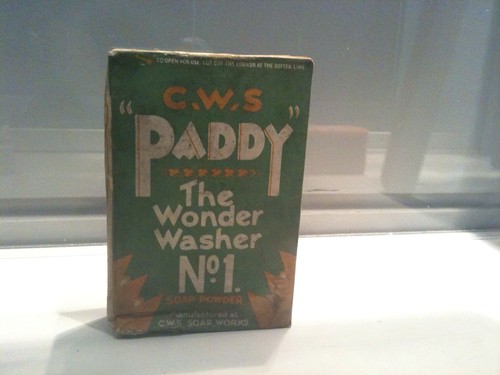We've had a lot of rain recently, and this is summertime not the spring or autumn deluge. Now I wish I had a better copy of this photograph from February 1923. The River Mersey has broken its banks, Jackson's Boat is in the distance and that is Rifle Road under water. Thankfully the flood defences on the River Mersey were built higher and higher in the 1980's and scenes like this will not be seen on this stretch of the river again. Well if it does happen in the future, there will be soon a tram track running to the right side of this picture and there won't be any service on that line.
Checking the level of the River Mersey is something I've done for years. You move to Chorlton and you casually observe that the sluice gates on the river are to take water out and not put it in. In short, when the river gets too high then go flood the meadows and any other low land.
Oh well, it's part of life but you just that you don't want to be the poor devil being interviewed by the local reporter with water breaching those sandbags around the front door .
Situated in a suburb of Manchester, England this is a story of a co-op store still with meeting rooms above the shop, and the lane itself. Plus other related or not so related history.
Friday, June 29, 2012
Wednesday, June 27, 2012
Chutney of Empire
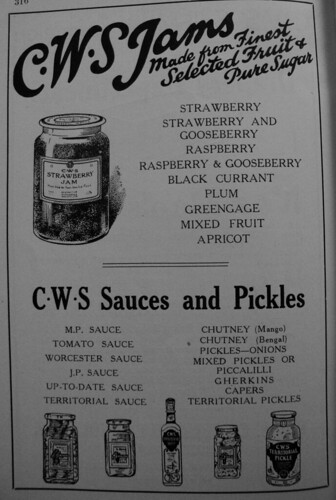
A relish from the Raj that made its appearance in Britain at the end of the 18th Century in the upper class households, and was adopted by successive classes to become a national condiment. Now every grocery store, faux farm shop, pseudo farmers market and delicatessan stocks the stuff.
Hobson Jobson, Yule & Burnell's 1886 glossary of Anglo-Indian words, cites chatna from 1813 and chatnee from 1820. From which you get the modern English spelling chutney. If you were wealthy enough you could buy imported chutney, or get cook to rustle up a batch that used apples and onions instead of mangoes and tamarinds. Recipes in Eliza Acton's Modern Cookery for Private Families ( 1845) or Mrs. Beeton's Household Management (1861).
Moving on a bit prices fell, and production from every pickle and sauce maker increased. Here we have the CWS advert from 1926 which has a Bengal chutney (that's short hand for hot, just like the description Mexican these days), and a mild sweet mango chutney.
Green Label Mango Chutney by Sharwood's become one of the leading brands after WWI and it still is. You'll find in The Co-Operative store and just about everywhere else. Just check out the illustration from the 1920's. It might have been made in a factory in London but you've got a character out of the Arabian Nights giving it authenticity. Heinz made a tomato chutney - tomatoes were their ingredient of choice for ketchup, soup and beans. Crosse & Blackwell were also leading purveyors.
I do like some of the names the evoke the colonial period, still available when you track them down. Major Grey's Mango Chutney was supposedly named after some chap in the Bengal Lancers. The best is Colonel Skinner's Mango Chutney, now he was a real soldier in India with his own horse regiment.
Now I've tried to explain chutney to friends from the other European countries. They look puzzled when I explain it is like a spicy jam and goes particularly well with poppadoms or as an extra filling for a sandwich.
However what was once an exciting new food from the Jewel of the Empire has been adapted to modern tastes. That is sweet and homogenised. Loaded with cheap sugar from beet, and there are brands out there are using high fructose corn syrup, having a texture that is gloppy sticky paste. When you see it in squeezable plastic containers you've hit another nadir in good taste. When you get the watery let down served in restaurants you've been done again. Don't fret there are still good chutneys about.
On the home made chutney front it became the salvation for the glut of fruit and vegetables. Back in WW2 days the Ministry of Food issued information to make Green Tomato Chutney. It had been around for decades because unripe tomatoes are that blessing or curse of English summers. The adoption of a foreign food to become an institution is a fascinating development and we should be pleased it has happened. Why eat plain when there is a jar of chutney in the cupboard.
Links for further reading :
Hobson Jobson : Anglo-Indian dictionary online.
Military memoir of lieut.-col. James Skinner is available at the Internet Archive, but only the Google Books version appears to have all the pages. It's here.
Previous posts in the Foods of Empire series are these.
Monday, June 25, 2012
Victory Year Co-Op Day

The first Saturday of July has been International Co-operators Day since 1923. Sometimes it is marked with events, in more recent years a family fun day in Morcambe, though i do remember a big event in The Lowry and in front of it a few years ago. Picture is for the 1945 celebrations in Wythenshawe Park which was also used as a Victory Celebration. All the usual timetable of events with speeches, children's sports and brass band.
Note the presenter of the prizes was to be Councillor Alf Robens who would have just been elected MP for Wansbeck, Northumberland two days earlier. Alf was born in Chorlton-cum-Hardy in 1910 and is best remembered for his days as Chairman of the National Coal Board (1960-1971).
The official opening was to be conducted by Councillor Elizabeth Yarwood, a Labour & Co-operative Party member, later to become a director of the Manchester & Salford Co-op, Lord Mayor of Manchester and awarded a Damehood in 1967.There is an Elizabeth Slinger Court, an appartement block in Wythenshawe. One year you are opening a festival in the park and thirty years later they name a nearby building after you.
There is a lot of history attached to the CWS (Manchester) Band which started out as the Tobacco Factory band but this is outside my field.
Saturday, June 23, 2012
Co-Operatives Fortnight

This leads into that shortfall, nay a lack of engagement between co-op events and going shopping at your local store. Both operate in different silos. I've discussed this issue over the years with active co-operators without coming to any conclusions. Retail is about attracting customers and stocking the shelves for them. Everything else is extra work for staff, and extra reading for the customer who isn't particularly interested. Now Fairtrade Fortnight works quite well. You can display the produce, and have special offers. The effort is reflected in sales. When there is a less tangible issue with no purchases required - then what? How many people know about The Co-op Group's campaign against oil tar sands?
Thursday, June 21, 2012
Co-Operate App
Essentially find a co-operative nearby with your mobile device. Yes, I downloaded it, and yes it came up lots of co-operatives in the vicinity and beyond. Just as it says in the write-up.
"Co-operate makes it easy for people to find co-operatives and mutuals across the UK. Whether they need food or phones, electricity or banking, Co-operate allows customers to download a better world on to their mobile phone."
Being a big fan of information at the fingertips this sort of thing appeals to me. Available for iPhone and Android and it is free. Hope the information will be kept up to date.
Details here.
"Co-operate makes it easy for people to find co-operatives and mutuals across the UK. Whether they need food or phones, electricity or banking, Co-operate allows customers to download a better world on to their mobile phone."
Being a big fan of information at the fingertips this sort of thing appeals to me. Available for iPhone and Android and it is free. Hope the information will be kept up to date.
Details here.
Wednesday, June 20, 2012
What Man's Tea?
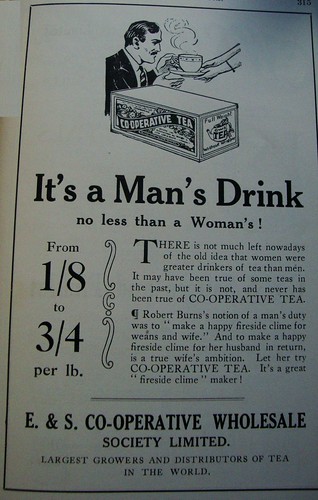 Couldn't let this one pass. What were they thinking of? Tea is a man's drink. Since when was it not? Maybe there was some old myth that women sat around drinking endless pots of tea and men guzzled beer. Now I've always taken it as read that tea was for all classes and all genders. You put the milk in first, or after was the seperating class factor. I drop it in after the tea is poured - that's habit and logistics of measurement.
Couldn't let this one pass. What were they thinking of? Tea is a man's drink. Since when was it not? Maybe there was some old myth that women sat around drinking endless pots of tea and men guzzled beer. Now I've always taken it as read that tea was for all classes and all genders. You put the milk in first, or after was the seperating class factor. I drop it in after the tea is poured - that's habit and logistics of measurement.
The illustration dates from the 1920's. You have a seated man in a suit, tie and moustache being served a brew from the hands of a women. Then you get a paraphrase from Robert Burns "Epistle to Dr. Blacklock" (1789). The real verse reads somewhat different and with a different meaning
"But to conclude my silly rhyme
(I'm scant o' verse and scant o' time):
To make a happy fireside clime to weans and wife,
That's the true pathos and sublime of human life."
I'll sign off with....."The past is a foreign country: they do things differently there." Those immortal lines from the Go-Between by L.P. Hartley (1953). This is days of loose tea sold in 4 oz packets (113 gms) in that foreign country.
Illustration from People's Year Book 1926.
Monday, June 18, 2012
Refreshing Soap
A continuation of cleaning with something from the personal hygiene archive. The line drawing is from 1930 and features some young chap getting his hands clean at the sink. It reminds me of the illustrations for Just William, a series of children's stories by Richmal Crompton which started in 1922. They get a revival for Tv, radio & etc every few years.
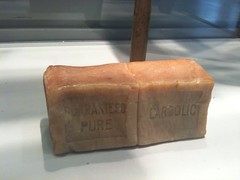
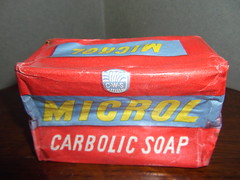
In the 21st Century soap is sold on its soft fragrances. Jasmine, rosemary, geranium and primrose. In an earlier age there was a market for almost medicinal, disinfectant soaps. The carbolic, which was made with the particular pungent phenol C6H5OH.
A scent for ever associated with schools, hospitals and other institutions up until the 1970's. Then there was the legendary Wright's Coal Tar Soap (from 1860 onwards), and if that didn't get you clean then nothing would. Don't forget the Lifeboy soap (Lever Brothers 1895) that claimed it would remove any traces of body odour. Apart from the later the others are hard to find these days. Not the products to find in a shop that sells all manner of gentle, kind to your skin, soaps.
Pictures of the Carbolic Soap: left, one spotted in Gallery Oldham the other day. A museum exhibit of how we used to bathe. Right side is from Cooperative Stores on Flickr, your daily fix of co-operative pictures both past and present. Related Post : Soap Bar


In the 21st Century soap is sold on its soft fragrances. Jasmine, rosemary, geranium and primrose. In an earlier age there was a market for almost medicinal, disinfectant soaps. The carbolic, which was made with the particular pungent phenol C6H5OH.
A scent for ever associated with schools, hospitals and other institutions up until the 1970's. Then there was the legendary Wright's Coal Tar Soap (from 1860 onwards), and if that didn't get you clean then nothing would. Don't forget the Lifeboy soap (Lever Brothers 1895) that claimed it would remove any traces of body odour. Apart from the later the others are hard to find these days. Not the products to find in a shop that sells all manner of gentle, kind to your skin, soaps.
Pictures of the Carbolic Soap: left, one spotted in Gallery Oldham the other day. A museum exhibit of how we used to bathe. Right side is from Cooperative Stores on Flickr, your daily fix of co-operative pictures both past and present. Related Post : Soap Bar
Sunday, June 17, 2012
Paddy Soap Powder
Sometime ago I made a posting about Spel Washing Powder. I was taken aback how many views it has received. There you go publishing a detailed piece of research about some historical footnote, nobody is interested. But a pack shot of a long gone washing powder gets the hits.
Spotted this old packet in a glass case in Gallery Oldham. It is not often I venture to an old mill town. But there is a new direct tram route and there was an exhibition of Liam Spencer paintings. Combine it into an adventure on light rails. It rained all day.
Paddy washing powder I don't know much about. It was around in the 1930's and definitely into the 1960's. Made in Irlam and other CWS soap works, and sold in your local co-op store.
There was also a bar of carbolic soap and some dolly blue which you added to your wash for whiter whites in a small cabinet by the stairs on the first floor. Funny what gets curated and displayed and what doesn't.
Previous : Spel Washes Everything.
Spotted this old packet in a glass case in Gallery Oldham. It is not often I venture to an old mill town. But there is a new direct tram route and there was an exhibition of Liam Spencer paintings. Combine it into an adventure on light rails. It rained all day.
Paddy washing powder I don't know much about. It was around in the 1930's and definitely into the 1960's. Made in Irlam and other CWS soap works, and sold in your local co-op store.
There was also a bar of carbolic soap and some dolly blue which you added to your wash for whiter whites in a small cabinet by the stairs on the first floor. Funny what gets curated and displayed and what doesn't.
Previous : Spel Washes Everything.
Thursday, June 14, 2012
Local Members Meeting
Just to prove there were Members Meetings at Hardy Lane I found a notice in a Norwest Co-Op magazine from 1987. I might even been to it. We used to drift along to take a seat. Immediately the big concern was would the meeting be quorate. Can't remember what the quorum was but it might have been twenty members. Failure to obtain a quorum could result in the hall upstairs being removed from the schedule next time around.
At the top table would be the men and women from the various committees. You'd get a finance report which could either be brief and informative, or tedious references for you to look at the figures on page 23, page 29, page 36 & etc.
Then came the voting by either a show of a card, or a secret ballot into a sealed black box. All above board democratic stuff. Even at the time they were not very memorable but there used to be a sprinkling of older members who no doubt had been trooping down here for thirty odd years. Most of the others were involved with Woodcraft Folk who wanted repairs or a new coat of paint for the Hardy Lane Co-Operative Hall. I think there was a free raffle, and it was a prize of groceries or a voucher which made it a good evening when you won.
At the top table would be the men and women from the various committees. You'd get a finance report which could either be brief and informative, or tedious references for you to look at the figures on page 23, page 29, page 36 & etc.
Then came the voting by either a show of a card, or a secret ballot into a sealed black box. All above board democratic stuff. Even at the time they were not very memorable but there used to be a sprinkling of older members who no doubt had been trooping down here for thirty odd years. Most of the others were involved with Woodcraft Folk who wanted repairs or a new coat of paint for the Hardy Lane Co-Operative Hall. I think there was a free raffle, and it was a prize of groceries or a voucher which made it a good evening when you won.
Wednesday, June 13, 2012
Socialism & Co-Operation
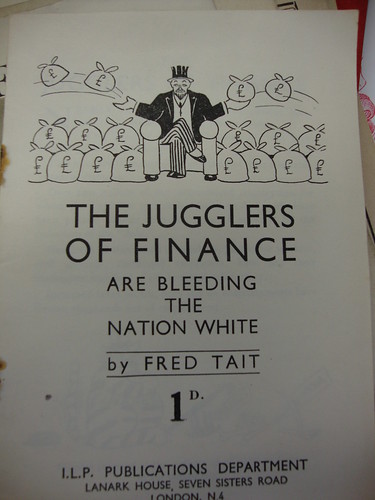 Are yes the bloated, fat cat capitalist. Substitute the frock coat, spats and top hat for the pin stripe suit and it could be 2012 not recession in the 1930's.
Are yes the bloated, fat cat capitalist. Substitute the frock coat, spats and top hat for the pin stripe suit and it could be 2012 not recession in the 1930's. This was an Independent Labour Party pamphlet and they produced many of them. There was one about Socialism and the Co-Operative Movement but it doesn't have an interesting cover - just a plain title.
So what did they have to say...
"Collective ownership, democratic control, the abolition of profit, production for use - these are the fundamental principles of Socialism as well as Co-Operation. Both Movements look to their universal application as the necessary foundation for the social system they desire. While Socialism is not yet a reality, the Co-Operative Movement already has done much to translate Socialist principles into practise, and where gaps exist between Socialist theory and Co-Operative practise their causes must be looked for, not in difference of principle, but in the circumstances which inevitably surround ant practical living experiment in the making of a new world."
Well it is still capitalist economics, there are still co-operatives, and then there is still the ILP publications. Discuss?
Tuesday, June 12, 2012
Lump Salt
Old style provisions I find a fascinating field of discovery. When soap literally came in long bars and the shop keeper cut off a slice for the customer, and sugar came in a big cone. Those two ways of selling still exist. The soap store chain called Lush sells cut and weighed soap. The loaf sugar I've not seen in the UK but is still available in Germany. Cut cheese at the deli counter is one of the last items that is still sold to a customer from a larger block.
In the days before sliced bread there was also salt sold in lumps. We're back in the years pre-1930. You sometimes see in antique shops tiny spoons referred to as salt spoons. Not that I've ever questioned why there was ever a need for a salt spoon. Apparently it was for distribution of the broken up lump salt at the dining table.
You can see the irreversible trend since the Hardy Lane store opened in 1929. Provisions, both food and non-food, have become sliced, diced, packaged and ready for use. Who is going to crush salt and pass the spoon these days. It has actually gone beyond that. Today you see chopped vegetables in plastic on sale in the chiller cabinet, and frozen roasted potatoes and the Yorkshire puddings to go with them.
In the days before sliced bread there was also salt sold in lumps. We're back in the years pre-1930. You sometimes see in antique shops tiny spoons referred to as salt spoons. Not that I've ever questioned why there was ever a need for a salt spoon. Apparently it was for distribution of the broken up lump salt at the dining table.
You can see the irreversible trend since the Hardy Lane store opened in 1929. Provisions, both food and non-food, have become sliced, diced, packaged and ready for use. Who is going to crush salt and pass the spoon these days. It has actually gone beyond that. Today you see chopped vegetables in plastic on sale in the chiller cabinet, and frozen roasted potatoes and the Yorkshire puddings to go with them.
Sunday, June 10, 2012
Ryvita the original
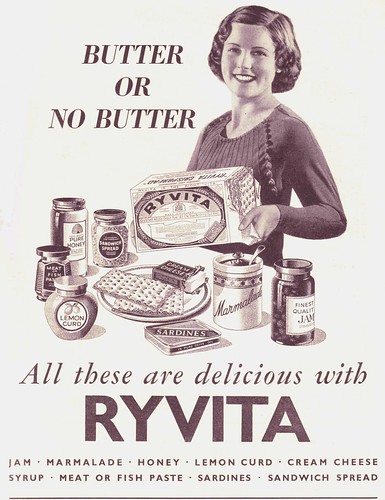
Ryvita has been on the shelves for as long as anyone can remember. It was first baked in 1927. One of those compound names taking the word rye with an etymology going back to Germanic and Nordic roots, and joining it a Latin or Italian word vita meaning life. Whilst pursueing through old British magazines of the 20th Century looking for anything but Ryvita I've noticed it is often there in print. Old co-op publications, back copies of Punch, and even early Vegetarian monthlies. That advertising budget was being spent to make it a popular brand. It is a dry, very dry but versatile cracker. Used to be promoted as an aid to slimming, at 35 calories a cracker it is true. But some of those toppings in the advert could pile on the weight.
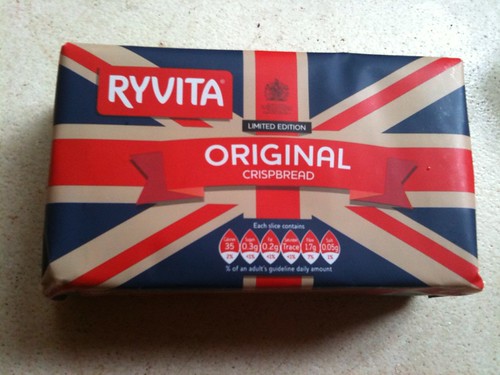
The ingredients are good essentially just rye and water. As it has the royal appointment then the company can justify the Union Jack wrapper to gain some jubilee sales.
Friday, June 8, 2012
Original Silk Cut pre-WWII
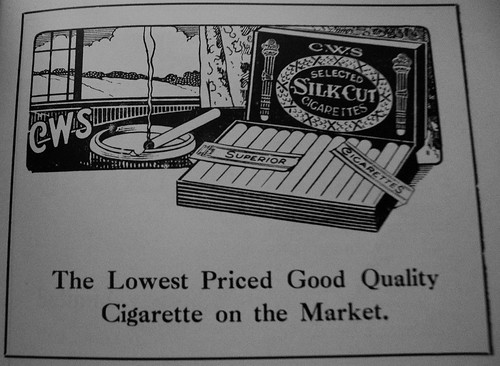
Silk Cut as you will know is a best selling brand of cigarette for the last twenty or more years. A 75-25 mixture of blonde tobacco and cytrel. It was made by Gallaghers which was bought by Japan Tobacco. So was a little puzzled by this CWS display advert from the 1920's.
Oh how times have changed. The co-operatives took a temperance line over alcohol and manufactured acceptable tobacco products. But alcohol now is faced up on whole isles in the stores, the CWS tobacco factory in Manchester was converted to appartments whilst the evil tobacco is disappearing behind closed cupboard doors. Already been to a few shops like The Co-Operative in Holmfirth, and Waitrose in Cheadle were the hidden policy is in effect.
Advert is from the People's Year Book 1926 published by the CWS, Manchester.
Wednesday, June 6, 2012
Withington Road

It's been a long time to actually get down to Withington Road, Whalley Range, Manchester to see this revealed sign of the old Manchester & Salford Equitable Co-operative. Well yesterday I incorporated it into a trip to Alexandra Park nearby. That was to see a tree sculpture depicting Votes For Women and the WSPU. Around the corner on Deerpark Road is an apartment block called Roy Grainger Court. I'm presuming this is named after the late Roy who was active for many years in the Labour Party, West Didsbury Residents Association and a member of the Co-Operative Party. Another photo opportunity.
Back to the subject of the photo. The building dates from around 1928, and the shop has been restored and the old sign across the top revealed and protected by a transparent plastic sheet. Close up you can see the green tile work, and the black and white chess board tile flooring. The shop had an hall above being the meeting room for the Women's Guild, Co-Operative Party and other auxiliary organisations.
Hardy Lane store built a year later was to a lower budget construction. It omitted the lovely glazed green tile work, and ornate details of this solid building.
Should you wish for a closer inspection than visit this collection of eight photos on Flickr
Earlier post when the sign was revealed, it was back in 2009 - here.
Sunday, June 3, 2012
Royal Biscuit Tins
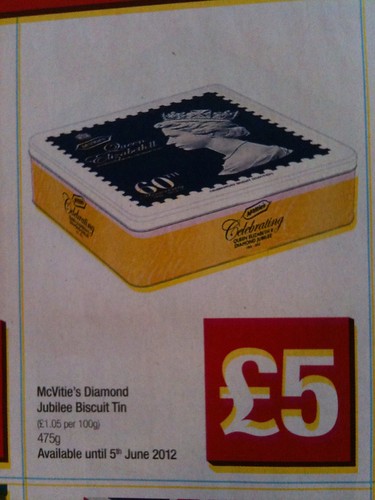
 Whenever you have a royal event then biscuit manufacturers get the tins painted up for the occasion. The Diamond Jubilee follows in this tradition. Advertisement (left) is from this week's glossy leaflet from The Co-operative that arrived with the free newspaper. Sure enough they were on the shelves in the shop. Bit tempted by a McVities. Oh how we like McVities. I wonder if they were made at their factory over in Levenshulme?
Whenever you have a royal event then biscuit manufacturers get the tins painted up for the occasion. The Diamond Jubilee follows in this tradition. Advertisement (left) is from this week's glossy leaflet from The Co-operative that arrived with the free newspaper. Sure enough they were on the shelves in the shop. Bit tempted by a McVities. Oh how we like McVities. I wonder if they were made at their factory over in Levenshulme?Wind the clock back 59 years to the Coronation and you have CWS biscuits manufactured at both their Cardiff or Crumpsall works. A collectors item and that's without you seeing the reverse side with an image of a dashing Duke of Edinburgh.
Royal biscuits date back to at least Queen Victoria with Huntley & Palmer making the Osborne in 1860 named after the big royal house on the Isle of Wight. There may have been Jubilee biscuit tins in her time.
Carr's made "Coronation Biscuits" with a vanilla flavour for Edward VII in 1902, and Huntley & Palmer produced "Royal Sovereign" filled with apricot jam for George V in 1912.
Note the decent interval of a year from the death of the last monarch to baking biscuits for the new one. When it came to Edward VIII the souvenirs for the forthcoming Coronation were in the shops in 1936. As we know it didn't take place, and George VI got the crowning in 1937, and the biscuit tins were in the stores. The CWS got the production lines rolling for commemoratives too.
There was a Silver Jubilee for George V in 1935. Those on unemployment benefit, and there would be many without a job received a little extra shilling, and 2/6d for under 14 dependents to mark the occasion. There has been no mention of a little extra for this year's event. However biscuits featured in the parties. "A gift of 30,500 caskets of biscuits has been made by Sir Alexander Grant for distribution at Jubille celebrations throughout Edinburgh" - Manchester Guardian 20th April 1935.
From the Coronation in 1953 the souvenir bandwagon has increased for each wedding, and now the third jubilee even more....
Now if heritage biscuit tins are for you then may I suggest you check out British Biscuit Tins with a searchable database and colour photographs.
The other good link is the Facebook page of the Museum of Brands, Packaging and Advertising. It is a trove of nostalgia. They have an exhibition ‘Jubilee, Jubilee’ which runs to 31st August 2012. Should you be in Notting Hill, London I recommend a visit, you won't be disappointed seeing the cornucopia of artifacts.
Saturday, June 2, 2012
Tram Bridge over the Mersey
 Let's see how the new tram route to Manchester Airport is progressing. These photographs were taken on Friday 1st of June, 2012. Seen many wagons and other vehicles going down Hardy Lane to the site where the bridge over the River Mersey is going to be constructed. It's higher than I anticipated. You could easily get a small boat or yacht with a mast underneath. Not that I have ever seen any navigation this high up the river. The occasional canoe but never a sailing craft. It's going to be another four years before the whole route is completed.
Let's see how the new tram route to Manchester Airport is progressing. These photographs were taken on Friday 1st of June, 2012. Seen many wagons and other vehicles going down Hardy Lane to the site where the bridge over the River Mersey is going to be constructed. It's higher than I anticipated. You could easily get a small boat or yacht with a mast underneath. Not that I have ever seen any navigation this high up the river. The occasional canoe but never a sailing craft. It's going to be another four years before the whole route is completed. The bottom picture is at the Jackson's Boat end of Hardy Lane. An elder tree is in bloom, the old bridge to the pub is on the left. It makes for a pretty country scene. You'd never guess that suburbia is on the doorstep.
The bottom picture is at the Jackson's Boat end of Hardy Lane. An elder tree is in bloom, the old bridge to the pub is on the left. It makes for a pretty country scene. You'd never guess that suburbia is on the doorstep.So despite all the disruptions and digging up the little bit of countryside there are still tranquil places.
Subscribe to:
Posts (Atom)
You can email : coop AT biffadigital.org with any information that will help in the making of this history.




